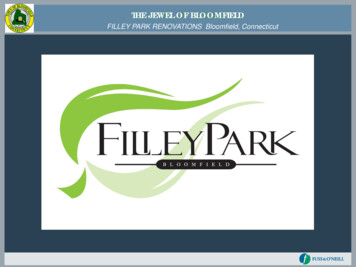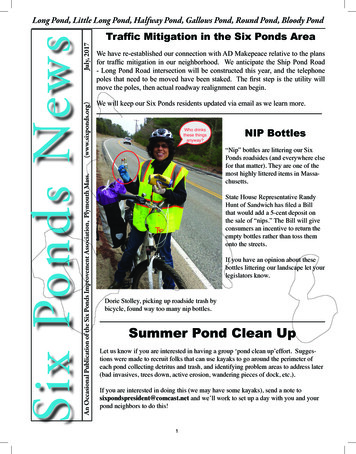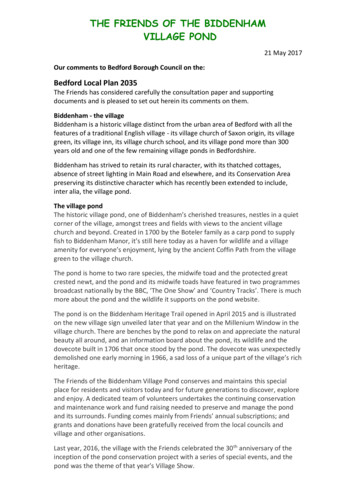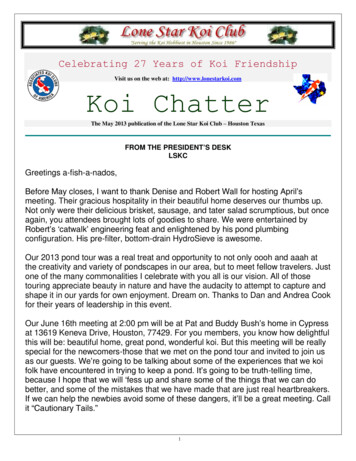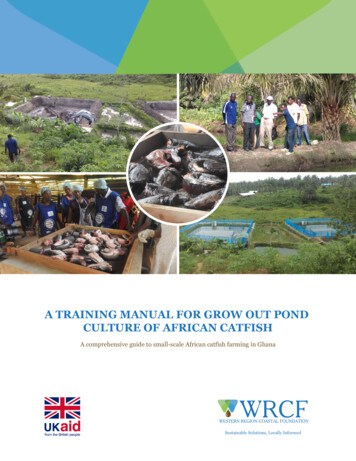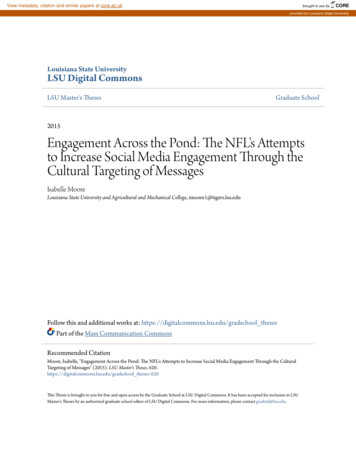
Transcription
View metadata, citation and similar papers at core.ac.ukbrought to you byCOREprovided by Louisiana State UniversityLouisiana State UniversityLSU Digital CommonsLSU Master's ThesesGraduate School2015Engagement Across the Pond: The NFL's Attemptsto Increase Social Media Engagement Through theCultural Targeting of MessagesIsabelle MooreLouisiana State University and Agricultural and Mechanical College, imoore1@tigers.lsu.eduFollow this and additional works at: https://digitalcommons.lsu.edu/gradschool thesesPart of the Mass Communication CommonsRecommended CitationMoore, Isabelle, "Engagement Across the Pond: The NFL's Attempts to Increase Social Media Engagement Through the CulturalTargeting of Messages" (2015). LSU Master's Theses. 620.https://digitalcommons.lsu.edu/gradschool theses/620This Thesis is brought to you for free and open access by the Graduate School at LSU Digital Commons. It has been accepted for inclusion in LSUMaster's Theses by an authorized graduate school editor of LSU Digital Commons. For more information, please contact gradetd@lsu.edu.
ENGAGEMENT ACROSS THE POND: THE NFL’S ATTEMPTS TO INCREASE SOCIALMEDIA ENGAGEMENT THROUGH THE CULTURAL TARGETING OF MESSAGESA ThesisSubmitted to the Graduate Faculty of theLouisiana State University andAgricultural and Mechanical Collegein partial fulfillment of therequirements for the degree ofMaster of Mass CommunicationinThe Manship School of Mass CommunicationbyIsabelle F. MooreB.A., The University of Nottingham, 2012May 2015
ACKNOWLEDGEMENTSI would like to thank all of the members of my committee, Dr. Amy Reynolds and Dr.Lance Porter, but particularly my chair Dr. Jensen Moore-Copple, for their patience with myinitially poor statistics skills, as well as their guidance, kind words, and pervasive calmness.I would also like to thank Dr. Keena Arbuthnot for reminding me that math isn’t really allthat bad, and for introducing me to SPSS. I am also forever grateful to Ryan DeLaune forreminding me of and guiding me through the processes of SPSS, and for his friendship andsupport.ii
TABLE OF CONTENTSACKNOWLEDGEMENTS . iiLIST OF TABLES . ivABSTRACT .vCHAPTERS1INTRODUCTION .12LITERATURE REVIEW .83RESEARCH QUESTIONS .204METHOD .245RESULTS .326DISCUSSION .39REFERENCES .55APPENDIXA.CODEBOOK FOR CODESHEET ONE: NFL UK TWITTER MESSAGES .60B.CODEBOOK FOR CODESHEET TWO: RESPONSES TO NFL UKMESSAGES .63C.TWITTER TERMS .65D.FREQUENCY AND CHI SQUARE TABLES .66VITA .70iii
LIST OF TABLESTable 1: Frequencies of tweet type and content .67Table 2: Frequencies of public relations model use.67Table 3: Chi-Square result for number of favorites across public relations models .67Table 4: Chi-Square result for number of retweets across public relations models .68Table 5: Chi-Square result for number of responses across public relations models .68Table 6: Chi-Square result for the overall sentiment of responses across public relations models.68Table 7: Frequencies of the inclusion of British-specific concepts across public relations models.69Table 8: Chi-Square result for number of favorites and the presence of British-specific concepts.69Table 9: Chi-Square result for number of retweets and the presence of British-specific concepts.69Table 10: Chi-Square result for number of responses and the presence of British-specificconcepts.70Table 11: Chi-Square result for the overall sentiment of responses and the presence of Britishspecific concepts .70iv
ABSTRACTWith more and more sports organizations reaching saturation points in their current homemarkets, the search for new, untapped, international audiences is on. Reaching out to these newmarkets has been made much more simple by the digitization of communication, and particularlythe global spread of social media. The NFL, as the United States’ most popular sports league hasbeen targeting the United Kingdom as it’s next market since the mid-2000s, and has gone as faras setting up a separate UK branch of their communications division (NFL UK). The NFL facesseveral challenges in engaging new fans in this fresh and culturally dissimilar market, andtherefore their communication efforts need to be highly engaging to help bridge the gapsbetween the two cultures.This two-part study examines whether Grunig and Hunt’s (1984) public relations models,can be traced from offline communications to online Twitter communications, specifically thoseof the NFL UK. The study also explores whether another facet of excellence theory, theinclusion of culturally specific concepts, is present in messages targeting a new marketplace, andwhether this inclusion impacts the engagement levels with those messages.The findings demonstrate that Grunig’s (1992) assertions that two-way symmetricalmessages are the most engaging type, while press agentry/publicity and public informationmessages are least engaging, are not supported in the case of the NFL UK’s use of Twitter.Instead the results of this study show that it is one-way communication models that receive thehighest levels of engagement from new audiences. The findings do, however, support the caseput forward by Grunig, Grunig & Dozier (2006), Wakefield (2007), Rhee (2009), and others, thatorganizations should attempt to incorporate in their messages terms and concepts specific to theculture that is being targeted.v
This study concludes by discussing the theoretical and practical implications of thesefindings. Elements of Grunig’s (1992) set of public relations best practices, as laid out inexcellence theory, do not easily translate to the world of digital communication, and often do notreflect at all in the messages of certain digital platforms, such as Twitter. An advancement ofexcellence theory is needed, particularly in relation to public relations best practices for theconstantly changing world of social media, as well engaging international audiences. The resultsof this study also indicate some practical implications; organizations hoping to engage audiencesembedded in a culture differing to their own should attempt to incorporate elements of thisculture into their messages. In the case of Twitter, instead of focusing on the type of tweet,communications departments should emphasize the importance of diverse but relevant content intheir messages when attempting to engage these new publics.vi
CHAPTER 1: INTRODUCTIONWith sellout crowds packing Wembley Stadium in London, attempts to increaseengagement in international markets for American football seem to be working (Panchev, 2014).The sport is the most prominent example of several recent attempts to bridge international gapsin major sports markets, stretching from bobsledding to rugby and cricket (Baker & Esherick,2013, p.220). The National Football League (hereafter referred to as the NFL) has been hostingregular season games in London for the last seven years, and has recently expanded theinternational series from one game a season to three (NFL.com, 2013). In order to fill thesegames and help create a steady and growing fan base, the organization has created a UnitedKingdom-specific communications branch, NFL UK. This division of the NFL organizationfaces several unique hurdles as they try to engage fans in their relatively new marketplace.In this arena traditional public relations issues combine with the problems of reaching anaudience with differing cultural touchstones, a lack of knowledge of the sport, and multiplealternative avenues to invest their time and money in sport. This thesis will explore whether NFLUK is successfully engaging their new British audience online with the use of public relationsexcellence theory. It will examine whether the organization is implementing traditional publicrelations models in its Twitter messages (Grunig & Hunt, 1984), whether it is includingculturally-specific concepts in these messages (Vercic, Grunig, & Grunig, 1996), and howeffective the use of both of these tactics are in engaging publics online.NFL in the UKSeveral previous efforts have been made to launch American football in both Europe andspecifically the United Kingdom within the last three decades, but significant British interest in1
American football is a relatively recent phenomenon (Allison, 2000, Ford & Foglio, 2005).Efforts to expand the sport in Europe advanced in the early 1990s when a European league wasformed with hopes of transforming it into a feeder league for the NFL (Ford & Foglio, 2005).This plan fell through as popularity for the sport waned in the early 2000s (Colangelo, 2014).Attempts to again introduce the sport into the western European marketplace were reinvigoratedby the NFL in the mid-2000s when the UK was pinpointed as the ideal target market (Ford &Foglio, 2011). Through these new efforts, the International Series was launched in 2007, whichmeans that each season at least one game is played at Wembley Stadium in West London inorder to grow interest in the sport and test the waters for a possible London-based franchise team(Colangelo, 2014).The current NFL UK campaign, run for the last seven seasons, has continued through thegrowth of digital communication as the fundamental method of advertising to and engagingaudiences; it now finds itself situated in a highly globalised and digitized world, wherecommunication must be fast, transparent, universal, and responsive (Li & Bernoff, 2011).Digitization has changed the world of sport and entertainment drastically, and communicationsdepartments have altered the way in which they find, form, and connect with fans (Billings &Butterworth, 2014). Sports fans can now connect with their favorite athlete, team, or sportonline, as well as find out information instantaneously and give immediate feedback (Gibbs &Haynes, 2013). Given the nature of sports as event-based products, they are especially wellpositioned to engage fans online by providing live event information (Sanderson, 2011).The objective of this study is to determine whether organizations attempting to engageaudiences online, which are based in a different culture, should alter the type and content of theirmessages in order to do so. By exploring the NFL UK’s use of Twitter over a nine-week period,2
this study determines whether use of James Grunig and Todd Hunt’s (1984) different publicrelations models impact the levels of engagement a tweet receives. Further examining Grunig’swork on excellence theory and it’s use in international public relations, the study also determineswhether including terms and concepts specific to the culture of the targeted audience improvesengagement with messages (Vercic, Grunig & Grunig, 1996; Grunig, Grunig & Dozier, 2006).By examining one organization’s use of Twitter as a method to engage a new public withdifferent cultural touchstones, this study attempts to determine the standards that organizationsfollowing in the NFL UK’s footsteps should adhere to.Public Relations Within Sports CommunicationThe swift proliferation of social media in the last decade has cemented the position ofsports online as one of the world’s largest and most easily accessible sources of entertainment(Billings & Butterworth, 2014). Not only has social media advanced the accessibility of sports,but it has also drastically advanced fan engagement and investment in sports brands andorganizations (Sanderson, 2011). With the vast majority of sports fans active online it is one ofthe easiest and most effective ways to connect with and influence a public (Li & Bernoff, 2011).Growing a fan base through social media has swiftly become the most common method in sportcommunication to engage an audience, and therefore create lasting relationships with them(Sanderson, 2011).For sport organizations attempting to break into a new market there are several hurdles,including already existent fan-team relationships, a lack of knowledge about the sport, andnegative feedback from the sport’s original fans (Gibbs & Haynes, 2013). Strategiccommunicators face significant barriers in not only finding and connecting with new, amiable3
publics, but also engaging them in meaningful relationships (Rein, Kotler, & Shields, 2006).These issues do not dissipate when the relationship moves online; often the limitations of digitalcommunication, specifically miscommunications, a lack of quantifiable measurement, andbarriers of digital literacy, exacerbate them (Rein, Kotler, & Shields, 2006). In order tosuccessfully navigate these barriers, organizations must implement a variety of communicationtactics, often in conjunction with each other.Organizations regularly use exhibition games between national teams, or regular seasongames to introduce foreign markets to their sports (Colangelo, 2014). These games helpfamiliarize the new market with the sport, while also gauging levels of interest in the sport andpossibilities for further expansion into the market. The NFL began hosting regular season gamesin London in 2007 in order to test the waters of the UK as a potential market; the game wasimmensely popular and led to a game each season in London between 2008 and 2012, for 2013two games were scheduled at Wembley Stadium, and in 2014 three regular season matchupstook place in London (Kaplan, 2014).Due to the live action nature of their events, sports communication excels in the livestream format of the social network Twitter; scores of games and matches can be communicatedquickly and succinctly to audiences around the globe, individuals can interact with the parentorganization, team, or specific player, and group discussions can take place in real-timeinvolving fans from around the world (Williams & Chinn, 2010). The data collected for thisstudy will encompass a period of nine weeks including the three 2014 season games held atWembley Stadium in London. Messages sent by the organization during this period are likely tobe the most appealing and engaging of the year.4
The communications efforts, both online and offline, made before, during, and afterevents such as these exhibition games are vital; encouraging fans to engage with theorganization’s communications will mean that they are then more likely to engage with theevent. Success in the field of communications has shifted away from the number of impressionsmade by a message, toward the development of relationships between customers andorganizations (Paine, 2011). Online the method to measure these relationships is to look at thelevels of engagement occurring with the messages produced by the organization (Paine, 2011).Engagement, with regard to communication efforts, can be described as what people do with theinformation provided in a message; it is no longer enough for a message to just reach a largeaudience, the goal is now for these people to read the message, comment on it, signify theirpleasure or displeasure with it, and ideally share it with others (Paine, 2011).Social media has been shown to be the most effective method through whichorganizations can reach and engage potential and already existent publics (Williams & Chinn,2010), and measuring this engagement allows for organizations to test the value of interest intheir event, and sport as a whole. In new marketplaces, initial and continued efforts to engageaudiences before, during, and after events will maintain and strengthen customer-organizationrelationships (Rein, Kotler, & Shields, 2006). The communication model traditionally mostsuited to engaging audiences, is the two-way symmetrical communication model, one of the fourmodels classified by Grunig and Hunt (1984). With audiences able to choose or reject messagesvery simply online, the message must be designed to reach the right audience and engage them,rather than the largest audience (Paine, 2011). The communication strategies surrounding theoffline events of NFL UK are designed to help overcome the hurdles faced by established sports5
entering new markets: the messages used must help educate new fans, engage audiences, andrecognize the cultural differences between the established sport and its new marketplace.Public Relations Across CulturesAlthough there is a small base of research in public relations for sports entering newmarketplaces, the field is fairly sparse, with the focus primarily on the strategies and tactics ofsports organizations in their already established markets. The NFL may be the most recent andprolific attempt at crossing international boundaries in search of a new marketplace, but othersports organizations have already found saturation in their local market and were forced to lookfurther afield for expansion (Baker & Esherick, 2013). The topic deserves more attention, as it islikely to be a pressing issue in the world of sports in years to come. The Information Revolutionhas brought us all a lot closer together, political changes worldwide are slowly opening upinternational markets, and the recent global economic crisis has meant that more and moreorganizations are looking outward to international markets to sustain themselves or grow.Launching in international markets is likely to become a future necessity in many sports, and thecommunication efforts used to advance and bolster these efforts should be examined.Although there have been cross-cultural efforts by the National Basketball League, andthe World Rugby organization, among others, never before has such a large and already wellestablished sports organization attempted to move into a new international marketplace (Baker &Esherick, 2013). The NFL is spearheading the first global shift in a digital sports world. Thisstudy will explore the methods used by the NFL UK in order to engage fans on Twitter, whetherthese methods are effective in engaging publics, and whether the methods used recognize and6
reflect cultural differences in their new target market, and if doing so is positively received byaudiences.This study will contribute to the growing literature exploring excellence theory inpractice around the world; it is uniquely placed as the first research to examine the role of globalexcellence theory principles in communications designed by one culturally specific organizationfor another culturally different audience; as well as exploring the continuing value of excellencetheory in digitized communications. Its findings can be examined and used by both scholarsexploring the expansion of excellence theory into the digital communication domain, andpractitioners hoping to utilize Twitter as a tool for engaging a new, culturally distinct audience.7
CHAPTER 2: LITERATURE REVIEWExcellence theory has long been held as the standard best practices for public relationspractice (Grunig & Grunig, 2008), however, in recent years the theory has come under fire forfailing to advance and adapt quickly enough in two key areas: online communication andinternational communication (Waters & Williams, 2007; Rhee, 2009). These two areas havebecome vital for modern public relations practitioners to master. The digitization ofcommunication has opened the world up for the possibility of fast, cross-continental engagementand the option of organizations reaching out to new marketplaces with little to no risk to theirstanding in their current market. Grunig’s ongoing work in the field of excellence theory hasattempted to adapt his set of public relations best practices to this new communication landscape.This study will attempt to gauge how successful these attempts have been and the continuingvalidity of the theory in digital communications, by examining the Twitter communications ofNFL UK.Grunig and Hunt’s (1984) Four Models of Public RelationsIn 1984 James Grunig and Todd Hunt together formulated the four models of publicrelations that would later form the backbone of Grunig’s excellence theory (1992). The fourmodels define the different ways in which organizations communicate with their publics. Thefirst model, press agentry/publicity, is a one-way type of communication that “uses persuasionand manipulation to influence audiences to behave as the organization desires” (Dozier, Grunig& Grunig, 1995, p.41). The second model, public information, is also a one-way type ofcommunication that “uses press releases and other one-way communication techniques todistribute organizational information” (Dozier, Grunig & Grunig, 1995, p.41). The third model,8
two-way asymmetrical, is an imbalanced two-way type of communication that “uses persuasionand manipulation to influence audiences to behave as the organization desires” (Dozier, Grunig& Grunig, 1995, p.41). Finally the fourth model, two-way symmetrical, is a two-way type ofcommunication that “uses communication messages to negotiate with the public, resolve conflictand promote mutual understanding and respect between the organization and its stakeholders”(Dozier, Grunig & Grunig, 1995, p.41).Two-way Symmetrical Communication and Excellence TheoryGrunig expanded on his and Hunt’s work over the next decade to form his excellencetheory, a set of best practices for public relations (1992). In his subsequent work on excellencetheory, Grunig suggests that to best engage publics practitioners should use the two-waycommunication model (Grunig, 1992). The basis of the two-way communication model as afundamental principle of public relations relationship building was set out in Grunig and Hunt’swork (1984), but excellence theory goes on to state that public relations practitioners should usetwo-way symmetrical communication to create campaigns that balance the organization’sobjectives with the public’s expectations and values (Grunig, Grunig & Dozier, 2006). It is thejoint satisfaction of these expectations that in turn encourage a long-term, mutually beneficialrelationship between an organization and its publics (Grunig, Grunig & Dozier, 2006).Regardless of the organization’s overall objective, or the context in which they areproducing their messages, Grunig argues that two-way symmetrical communications, messagesthat make up a mutually beneficial conversation between the organization and its stakeholders,should be used. This kind of message should balance the interests of the organization and itspublics, and should be used to resolve conflict or promote mutual understanding between the9
two. For example, messages that engage with individual stakeholders on a personal level, whileattempting to improve the individual’s experience and encourage feedback, are classified as twoway symmetrical communication (Grunig, 1992). The prevalence of excellence theory in publicrelations research and practice suggests that even though the NFL faces several non-traditionalbarriers in their communication strategies, they will form their communications based on theideal two-way symmetrical model.An organization’s relationship with its publics is of critical importance in the age of Web2.0 (Mangold & Faulds, 2009). Social media has made it possible for consumers to communicatetheir opinions directly to the organization and other consumers; organizations should engagetheir publics in meaningful dialogue through social media in order to gain the most insight intotheir current and potential audiences. Excellence theory asserts that an organization’s behaviorhas more effect on the organization-public relationship than its messages, as members of a publicare much more receptive to an organization’s messages when they feel that the organizationvalues their opinions (Grunig, Grunig & Dozier, 2006). The theory purports that the manner inwhich the organization engages with its audience, that is its choice of public relations model, willimpact the organization-public relationship and engagement between the two. Without publicsengaging with the company’s communication efforts, the company cannot produce programs orproducts that align with consumers’ interests (Mangold & Faulds, 2009).The Four Models of Public Relations and Excellence Theory in the Digital AgeGrunig and Hunt’s (1984) four models have been a stalwart of public relations practicesince the mid 1980s, but they have not yet been adapted to suit a rapidly alteringcommunications landscape (Grunig & Grunig, 2008). Grunig still advocates for the use of the10
original four models in public relations practice today, arguing that if a digital platform is notsuited to all four models, then different platforms should be used by an organization for eachmodel (Grunig, 2009). For example, an organization’s website could be used disseminatepublicity messages, while a community chatroom could more easily facilitate two-waysymmetrical communication (Grunig, 2009). Although there are arguments against the validityof excellence theory in modern public relations practice, particularly of the legitimacy of twoway symmetrical messages (Cancel, et al., 1997; Cameron, et al. 2001), Grunig and Hunt’s fourmodels are still taught today in public relations departments across the world. Though Grunighas left the four models untouched since 1984, he and his counterparts have continued to expandand adapt other elements of excellence theory over the last three decades, including featuresdesigned to facilitate its use internationally (Grunig & Grunig, 2008; Grunig, 2009).International Use of Excellence TheoryAlthough Grunig’s work was designed to be a global standard for public relations,providing a set of guidelines that could feasibly be enacted in different cultures around the world(Grunig, 1992), he did not specify their international applicability or test their use outside of theUnited States until 1996 (Vercic, Grunig & Grunig 1996), and it was not until the third iterationof his excellence theory that he recognized the growing importance of internationalcommunications (Grunig & Grunig, 2003). Once Grunig acknowledged the impact of culture onan organization’s communication efforts, he built the principle into his growing theory (Vercic,Grunig, & Grunig, 1996).The first researcher to actually test Grunig’s excellence theory (1992) outside of the USwas Robert Wakefield, who from 1995 to 1998 undertook three studies in order to test excellence11
theory in a real-world multicultural context. Published a decade later, his results successfullydemonstrated that excellence theory could be put into use in multinational organizations(Wakefield, 2007). Although the principles of the theory remained the same in different culturalcontexts, Wakefield showed that the specific applications of them varied, with the culture ofwhere the organization was situated impacting the manner is which it engaged in public relationsand the content of its messages (Wakefield, 2007).Once he had undertaken studies outside of the US, Grunig himself recognized the impactof contextual variables on the application of the excellence theory principles, stating that thevariables political-economic system, level of development, culture, extent of activism, and mediasystems all affect the methods with which the principles can be enacted (Vercic, Grunig, &Grunig, 1996). Grunig and his peers advocated for a set of abstract generic principles that couldbe globally applicable, but individual application of these principles would occur; he stated,“global public relations should fall in the middle between standardization and individualization”(Grunig, 2009, p.1). As the US and the UK have very similar political-economic systems, levelsof development, media systems, and levels of activism
It has been accepted for inclusion in LSU Master's Theses by an authorized graduate school editor of LSU Digital Commons. For more information, please contactgradetd@lsu.edu. Recommended Citation Moore, Isabelle, "Engagement Across the Pond: The NFL's Attempts to Increase Social Media Engagement Through the Cultural


